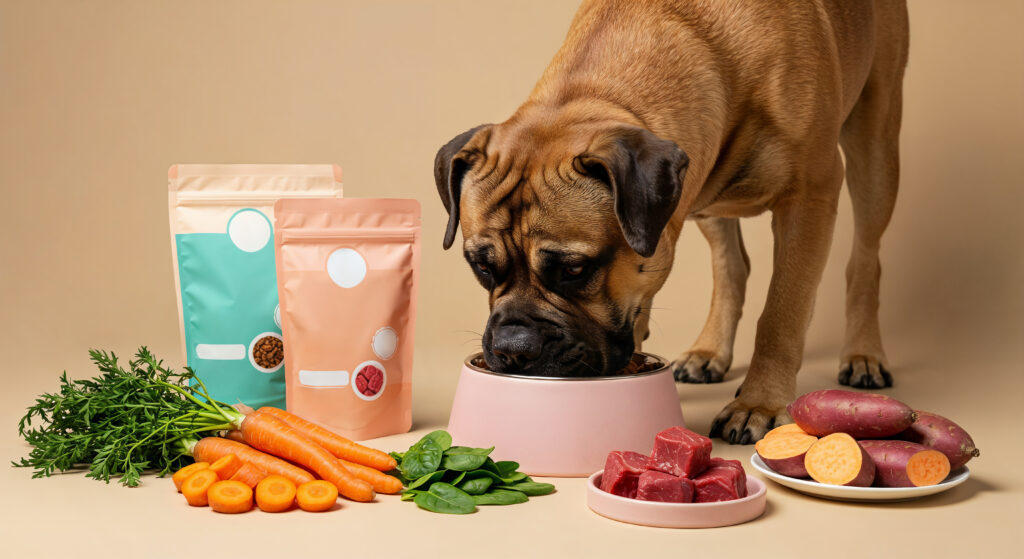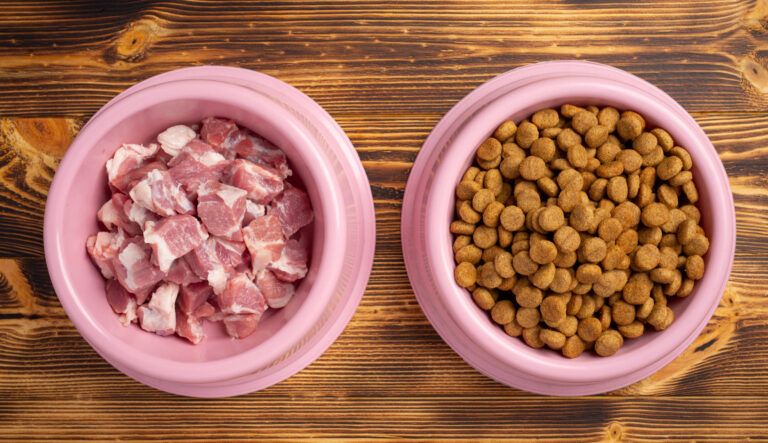
Does your dog constantly scratch, lick paws, or suffer from recurring ear infections? Food allergies might be the hidden cause. Many commercial dog foods are loaded with common allergens such as chicken, beef, dairy, soy, corn, or wheat. These ingredients may trigger itchy skin, digestive problems, or chronic discomfort.
The solution? Choosing the best dog food for allergies. With the right diet, you can control triggers, reduce inflammation, and restore your dog’s comfort. In this guide, we’ll explore how to identify food allergies, what to look for in allergy-friendly dog food, and which options—both commercial and homemade—work best. We’ll also share practical tips for transitioning diets and when to involve your vet.
Food allergies can mimic other conditions, so spotting them early is key. Some of the most common symptoms include:
Important: Not every itch means a food allergy. Fleas, pollen, and dust mites can also cause similar reactions. But if your dog has year-round symptoms that don’t improve with flea treatments or seasonal changes, food may be the culprit.
Practical example: Max, a 6-year-old French Bulldog, struggled with loose stools, constant paw licking, and red rashes on his belly. His owner initially thought it was seasonal pollen, but the symptoms never went away. After an elimination diet, they discovered Max was sensitive to beef and wheat. Switching him to a limited-ingredient salmon and potato formula not only cleared his skin but also improved his energy and digestion. Within two months, his stools were firm, his coat looked shinier, and the paw licking stopped almost entirely.
Allergy symptoms vary by dog, and sometimes they overlap with environmental issues. That’s why keeping a simple diary of what your dog eats, when symptoms appear, and how severe they are can help you and your vet identify patterns faster. Careful tracking saves time, reduces frustration, and helps you find the best dog food for allergies more efficiently.

Finding the right formula requires more than grabbing the “grain-free” label. Here are the key features:
These recipes contain fewer ingredients, making it easier to identify triggers. For example, a food with only one protein and one carb source allows you to track your dog’s reaction clearly. Some brands even label their food with “single protein source” so you know exactly what you’re getting.
Dogs often develop allergies after long-term exposure to common proteins like chicken or beef. Switching to novel proteins such as duck, venison, salmon, or lamb can reduce allergic reactions. Kangaroo and rabbit are also considered highly novel proteins for particularly sensitive dogs.
Some dogs react to grains like wheat or corn, while others tolerate rice or oats just fine. Grain-free doesn’t automatically mean allergy-friendly, so it’s best to work with your vet to decide which option makes sense.
Beef, chicken, dairy, soy, wheat, and corn are the top offenders. Look for foods that avoid these and focus on gentler, less reactive ingredients. Always double-check ingredient lists—even treats and supplements may contain hidden allergens like chicken fat or milk powder.
Omega-3 fatty acids, probiotics, and prebiotics are often added to high-quality allergy-friendly formulas. These help reduce inflammation, support digestion, and improve coat health.
Тip for you: Foods enriched with fish oil or flaxseed oil provide skin-soothing omega-3s that can make a visible difference within weeks.

Before we start, please note that not all foods are equal. Here are some of the best hypoallergenic dog food options available, based on veterinary recommendations and customer reviews:
Tip for you: When trying a new food, stick to it for at least 6–8 weeks before judging results. Switching too quickly or changing brands often confuses the process.

Both homemade and commercial foods have pros and cons. Understanding the differences helps you decide what works best for your dog’s unique needs.
Example recipe: A simple mix of turkey, sweet potato, spinach, and olive oil is a gentle, allergy-friendly option many dogs tolerate well. Another option is salmon with quinoa and peas, which provides omega-3 fatty acids, fiber, and easily digestible protein.
Some owners combine both, using commercial hypoallergenic kibble for balance and supplementing with homemade meals for variety. This hybrid method helps ensure proper nutrition while giving your dog fresh, tasty meals that reduce boredom. For example, you might feed a high-quality salmon-based kibble in the morning and serve a homemade lamb and pumpkin stew at night.
Tip for you: If you choose homemade food, ask your vet about supplements such as calcium, omega-3 oil, and multivitamins designed for dogs. This ensures your pet gets complete nutrition. If you choose commercial food, rotate between safe protein sources every few months to lower the risk of developing new allergies.
Switching diets too quickly can upset your dog’s stomach. Follow a slow transition:
During this period, monitor stool consistency, skin condition, and energy levels. Write notes in a small logbook or phone app to track progress. It can also help to take weekly photos of your dog’s skin or coat, so you can spot subtle improvements that may be hard to notice day-to-day.
Be patient—some dogs adapt quickly, while others need a little more time. Puppies and senior dogs may require even slower transitions, sometimes stretching to two weeks. Always provide plenty of fresh water, since dietary changes can alter hydration needs. If you notice loose stools, pause at the current transition ratio for a few extra days before moving forward.
Tip for you: Use healthy, single-ingredient treats (like dehydrated sweet potato or salmon) during the transition to avoid triggering allergies. Avoid table scraps and new snacks that could confuse results.
Signs the food is working: Less scratching, firmer stools, shinier coat, calmer behavior, improved appetite, and more consistent energy throughout the day.

Food changes can solve many allergy problems, but sometimes professional veterinary care is necessary. Contact your vet if your dog shows persistent or severe symptoms that do not improve with a diet change, or if their condition suddenly gets worse. Warning signs may include constant scratching, recurring ear infections, hair loss, red or irritated skin, or chronic digestive issues. These can indicate a deeper allergy problem or another underlying condition.
❗ Symptoms worsen despite diet changes
❗ Your dog loses weight or appetite, becomes weak, or seems unusually tired
❗ Severe reactions appear: vomiting, diarrhea, hives, breathing difficulty, or swelling of the face/muzzle
❗ You want to try a long-term homemade diet but need guidance to keep it nutritionally balanced
❗ Your dog develops ear or skin infections repeatedly
Your vet may recommend:
✅ Elimination diet to identify food triggers
✅ Blood tests or skin allergy testing for more complex cases
✅ Prescription diets, if necessary
✅ Medications like antihistamines or steroids to control inflammation
✅ Omega-3 supplements or probiotics to support long-term skin and gut health
Regular vet checkups ensure your dog stays safe and healthy during allergy treatment and dietary transitions. Don’t wait too long—early care prevents complications.

Usually 4–6 weeks. Skin improvements may take longer since healing is gradual.
Only if they contain the same protein and carb sources as the elimination food. Otherwise, they may interfere with results.
Not necessarily. Grain-free foods can help some dogs, but many allergies are linked to proteins like chicken or beef, not grains.
Yes, but only if carefully balanced with supplements. Otherwise, your dog may miss key nutrients like calcium or zinc.
The best dog food for allergies depends on your dog’s specific triggers, health needs, and lifestyle. Whether you choose a veterinary prescription formula, a high-quality commercial option, or balanced homemade meals, the key is consistency and observation.
Start with a limited-ingredient or novel protein diet, give it time, and watch how your dog responds. With patience and the right food, most dogs experience less itching, healthier skin, and happier lives.
For dog owners who want reliable veterinary sources for dog food allergies, here are trusted references:
Sale
Adopt Smart
By rating this topic, you’re helping us share more valuable, real-world solutions for dogs with allergies. Every click makes a difference!
Simple, science-backed dog health tips you can trust.
Empowering dog owners with proven solutions for allergies, nutrition & overall dog health.
© Copyright 2025 My PupEase –
All Rights Reserved.